total solar eclipse. Our offices will reopen on April 11th at 10:00 AM local time. We apologize for any inconvenience.
Astro Camera and Astro Conversion Filter Options
(Filter options that can be installed inside the camera during the modification process)
Full Spectrum(Clear) Filter Option: Our most versatile filter option. The Full Spectrum filter option is optically clear, allowing your camera to capture all ranges of the EM spectrum. The only transmission limitations will be the limits of your camera, not our filter. This allows the camera to capture images of deep space objects that are invisible to the human eye and allowing you to limit the sensitivity of your camera by using external filters of your choosing. This filter is manufactured from the highest quality polished and coated material. All our filters our polished to scientific microscopic image quality standards insuring flawless imaging under extreme magnifications. The Full Spectrum filter option is the most recommended choice for all types of Astrophotography, including Nightscapes and Deep Sky object photography. When shooting Nightscapes or Deep Sky imaging it is normally best not to use any type of limiting filters on your lens or with your telescope (with the exception of light polution filters if needed). See our tips page for information regarding White Balance settings to achieve the best results.
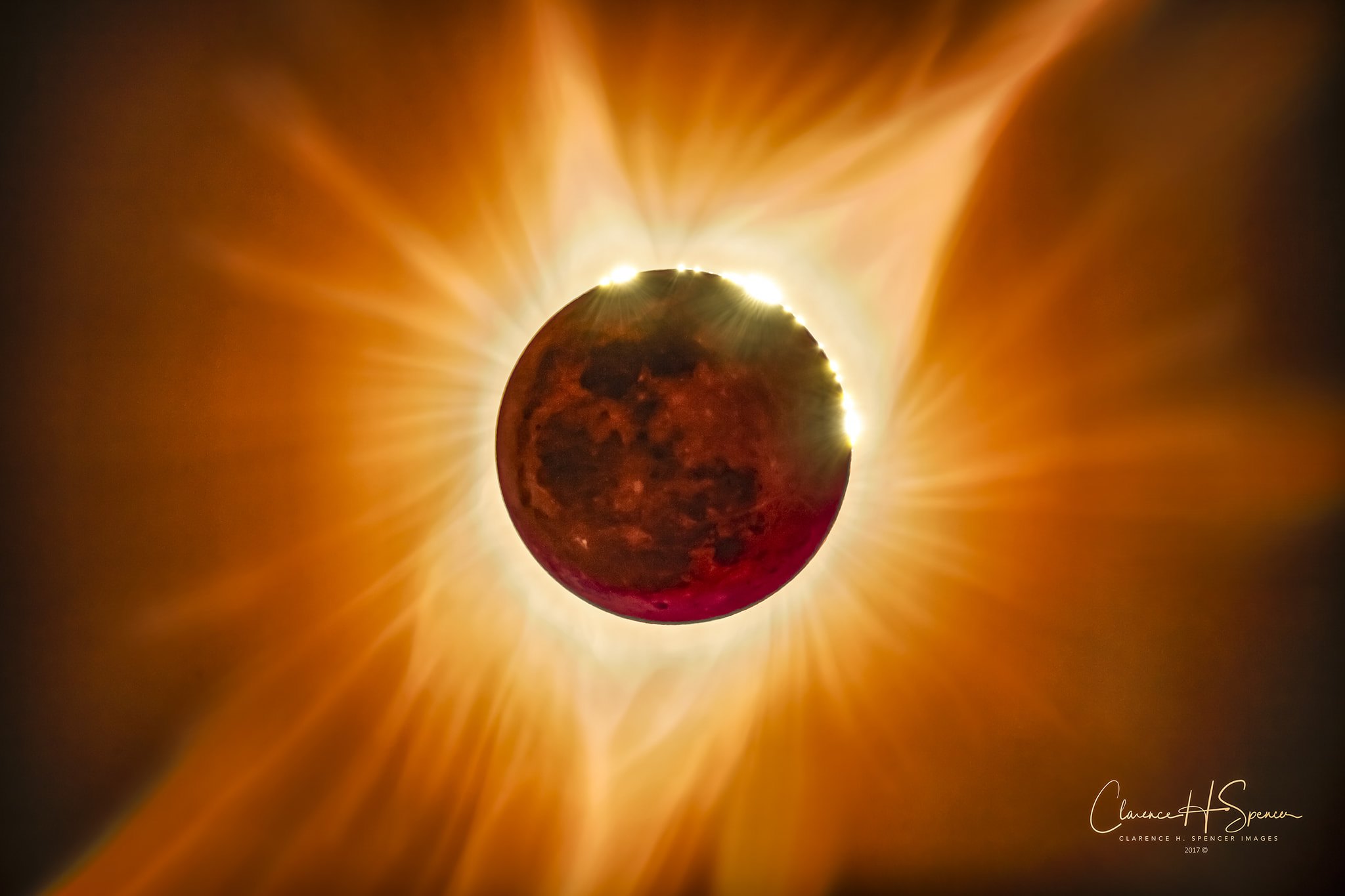
Solar Eclipse of 2017 - Canon EOS 5DS - Full Spectrum Modified **Be sure to excercise proper solar imaging safety. Always use a solar filter! You can damage your camera or your eyes if you do not use a solar filter properly.**
Visible + H-Alpha Filter (420nm - 680nm) - The Nightscaper/Night Landscape and Milky Way shooters favorite!: Not only do we offer a Full Spectrum/Clear filter installation we offer a Visible + H-Alpha filter option. This filter choice is the favorite choice of most experienced Nightscape shooters (Landscape at night and Milky Way images) Our Visible + H-Alpha filter will allow your camera to capture true color images with more transmission of the H-Alpha range than an unconverted camera while capturing the visible spectrum as well. Colors will remain natural and overall luminance is noticeably increased. (This filter option is nearly identical to the filter specifications used in the Canon EOS Ra but will allow your camera to capture even more luminance, colors, light transmission and wavelength, including H-Alpha.) The Visible + H-Alpha filter has a sharp cutoff at 680nm which allows imaging in the most popular narrow band ranges including: Hydrogen Alpha (H-Alpha), Sulpher II (S-II) Oxygen III (O-III), Nitrogen I (N-I), and Hydrogen Beta (H-B). Also, this filter is manufactured from the highest quality polished and coated material. All our filters are anti-reflective coated and polished to scientific microscopic image quality standards insuring flawless imaging under extreme magnifications. (The Visible + H-Alpha filter is also available in an On-Lens Version here)
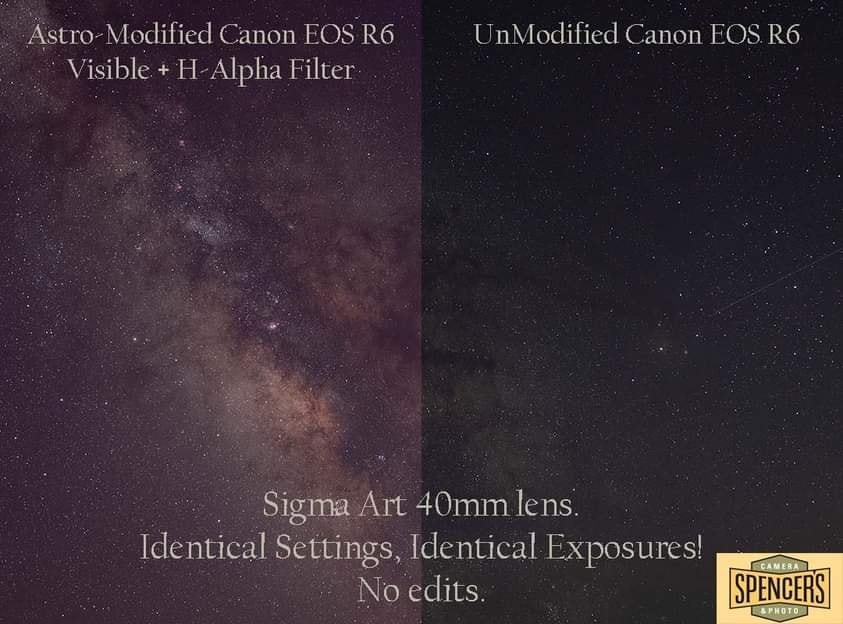
Comparison images captured with the same model cameras, identical lens and settings. One Astro-modified with the Visible + H-Alpha internal filter option and the other no modifications performed.
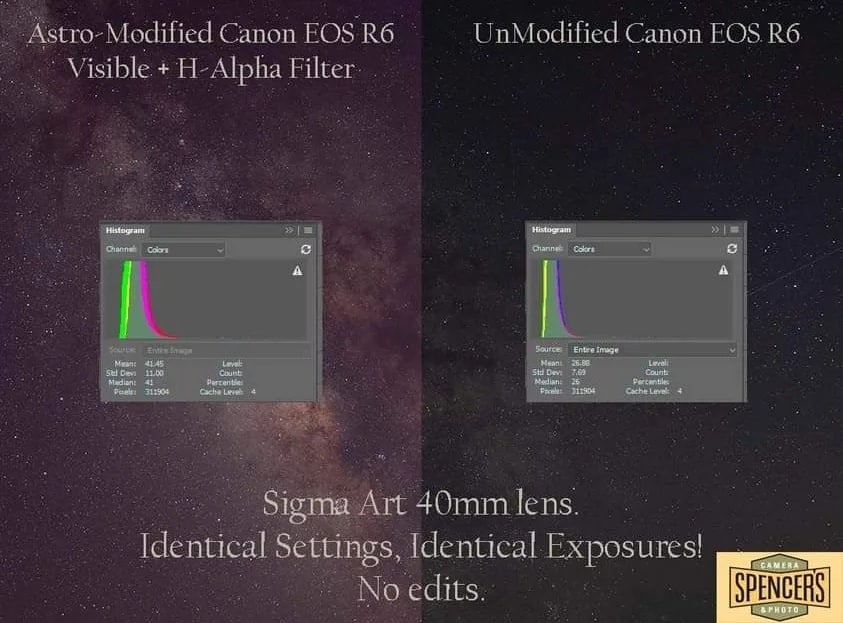
Comparison images captured with the same model cameras, identical lens and settings. One Astro-modified with the Visible + H-Alpha internal filter option and the other no modifications performed. Note the histogram differences.
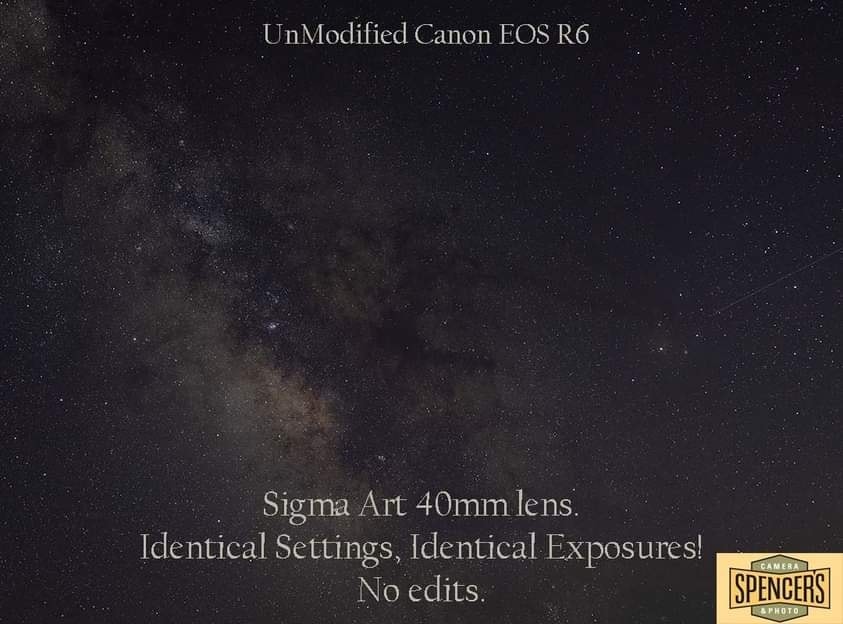
Comparison images captured with the same model cameras, identical lens and settings. One Astro-modified with the Visible + H-Alpha internal filter option and the other no modifications performed.
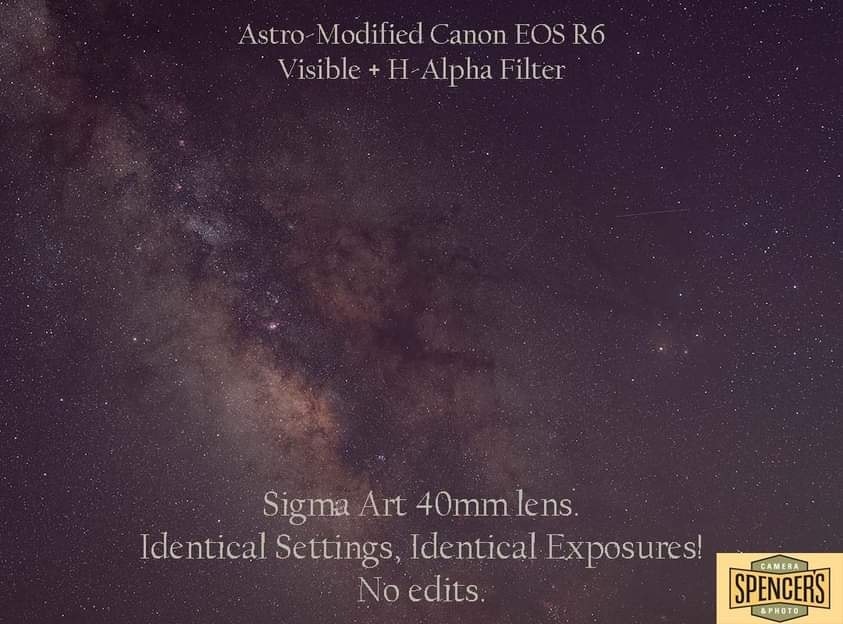
Comparison images captured with the same model cameras, identical lens and settings. One Astro-modified with the Visible + H-Alpha internal filter option and the other no modifications performed.
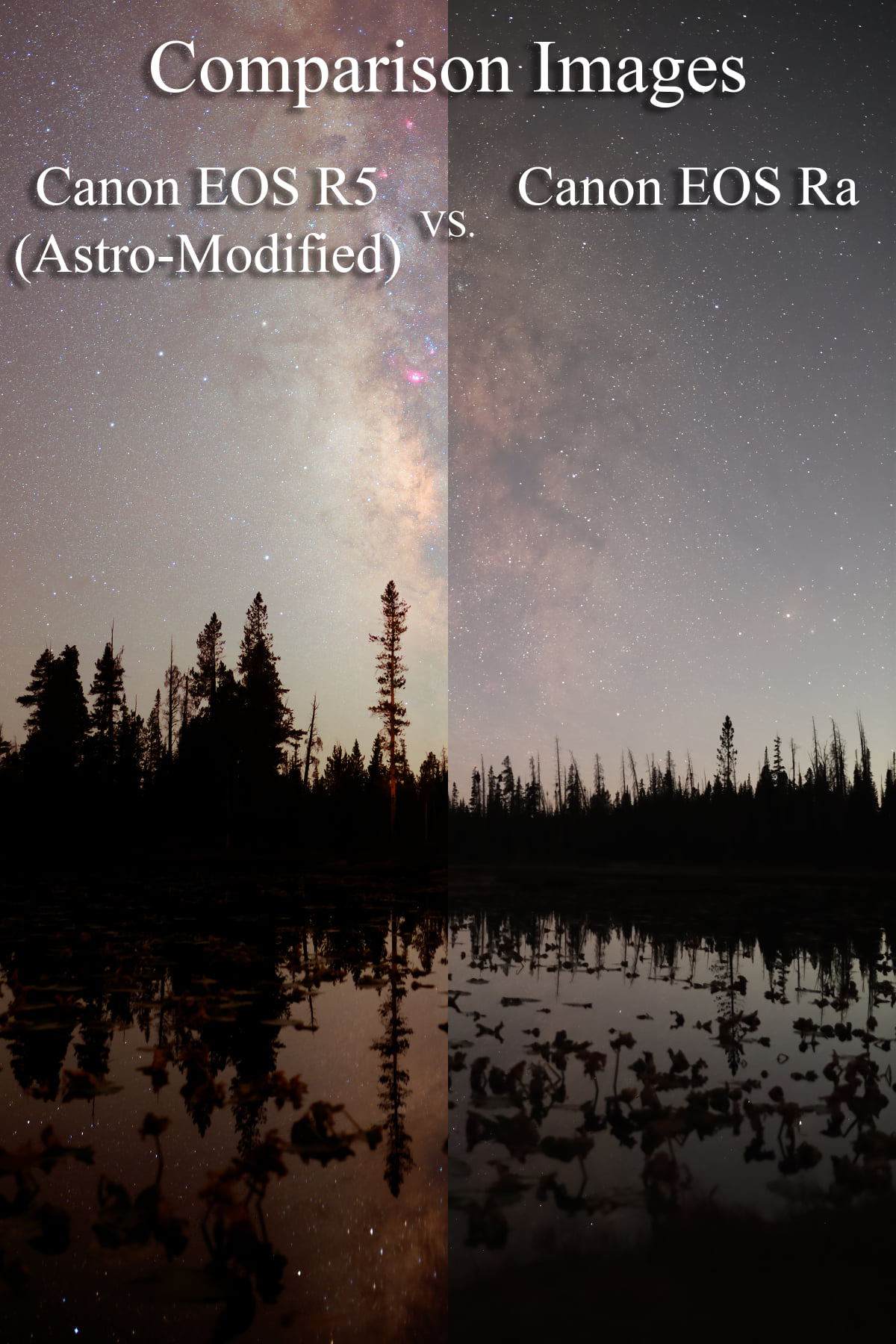
Comparison images captured using an Astro-modified Canon EOS R5 with the Visible + H-Alpha internal filter option and a Canon EOS Ra. Identical lens and identical settings. As is obvious, the modified camera out performs the astrophotography specific Canon EOS Ra with much more sensitivity to light (Increased Luminance) especially more sensitivity to the H-Alpha portion of the EM spectrum.
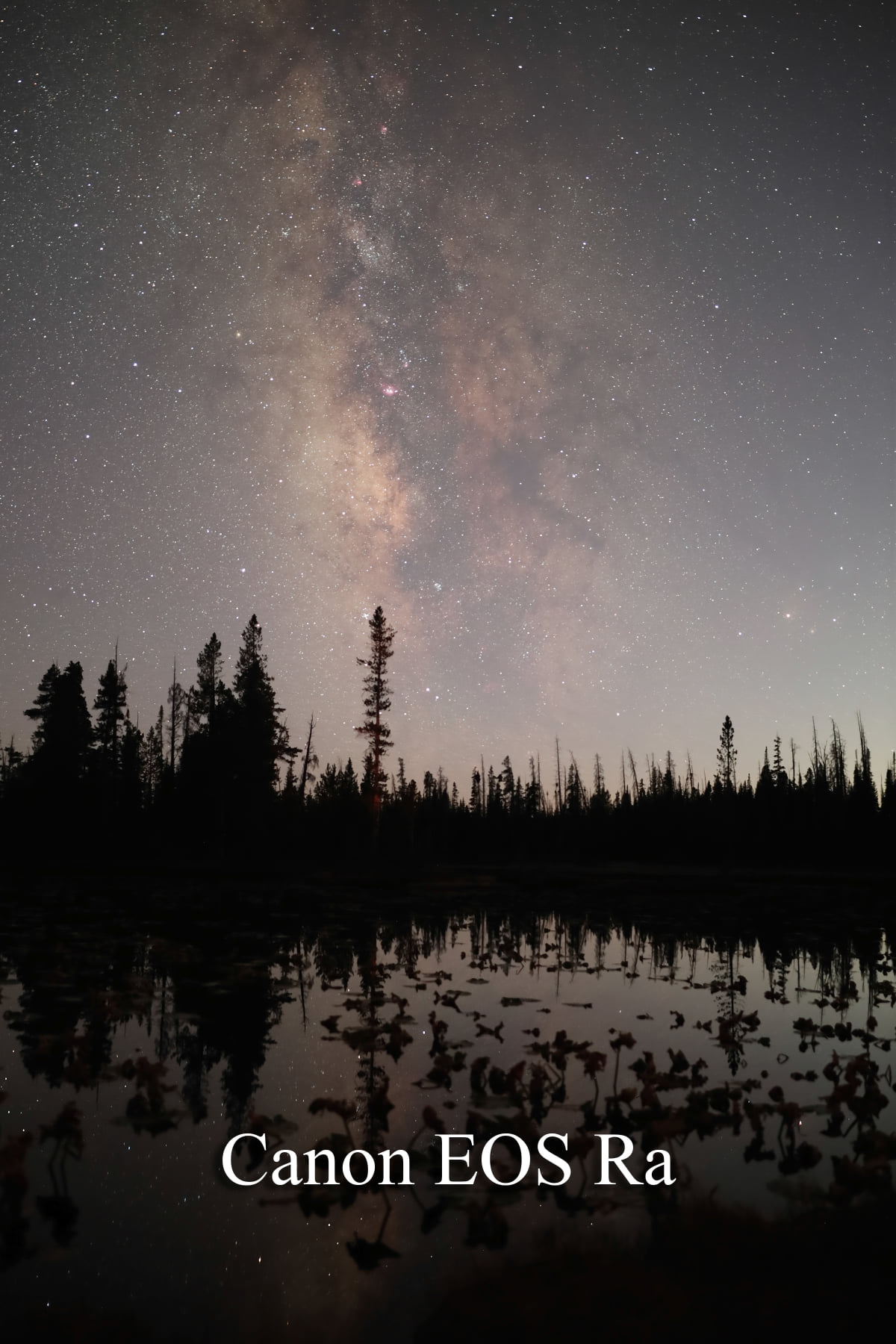
Comparison images captured using an Astro-modified Canon EOS R5 with the Visible + H-Alpha internal filter option and a Canon EOS Ra. Identical lens and identical settings. As is obvious, the modified camera out performs the astrophotography specific Canon EOS Ra with much more sensitivity to light (Increased Luminance) especially more sensitivity to the H-Alpha portion of the EM spectrum.
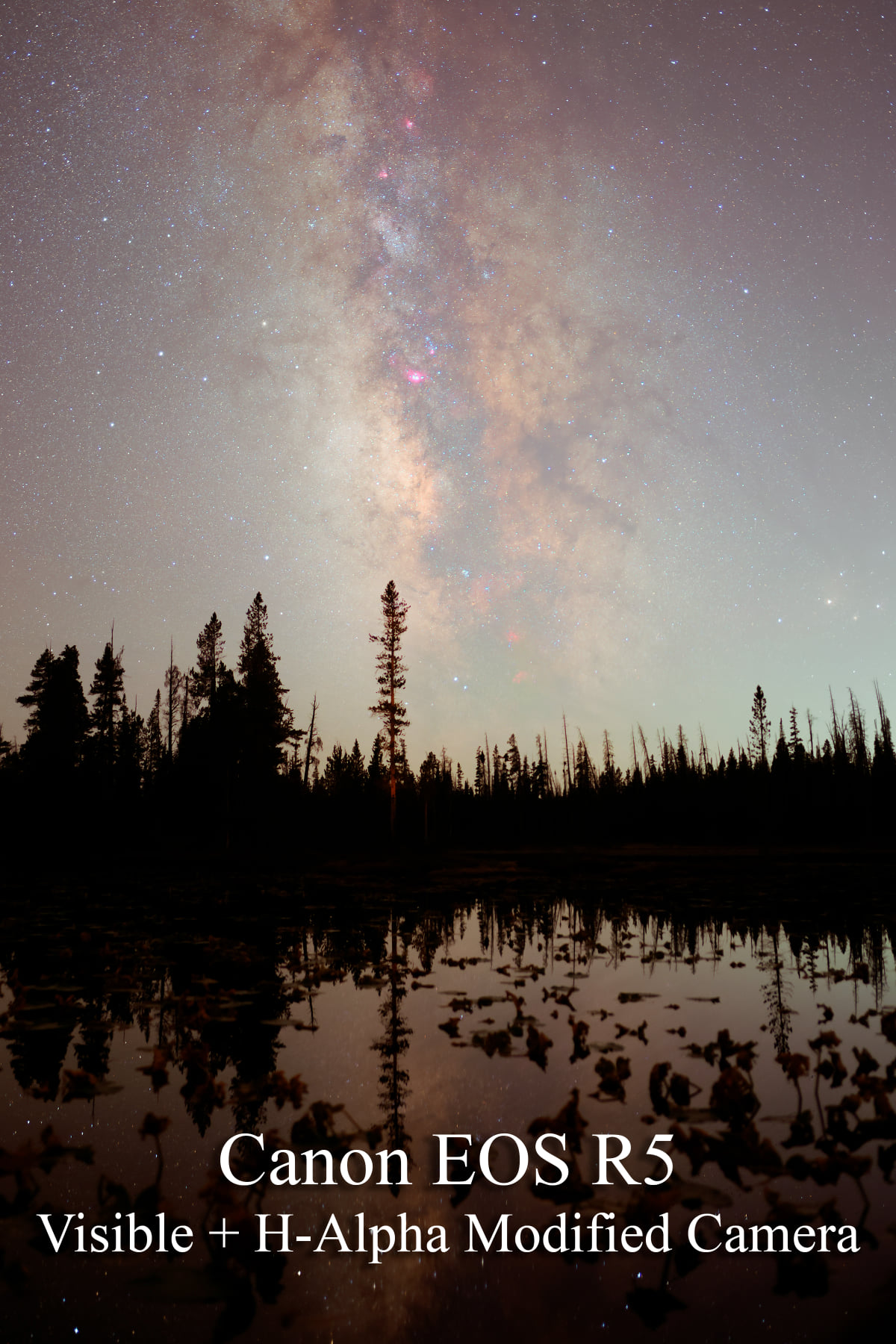
Comparison images captured using an Astro-modified Canon EOS R5 with the Visible + H-Alpha internal filter option and a Canon EOS Ra. Identical lens and identical settings. As is obvious, the modified camera out performs the astrophotography specific Canon EOS Ra with much more sensitivity to light (Increased Luminance) especially more sensitivity to the H-Alpha portion of the EM spectrum.
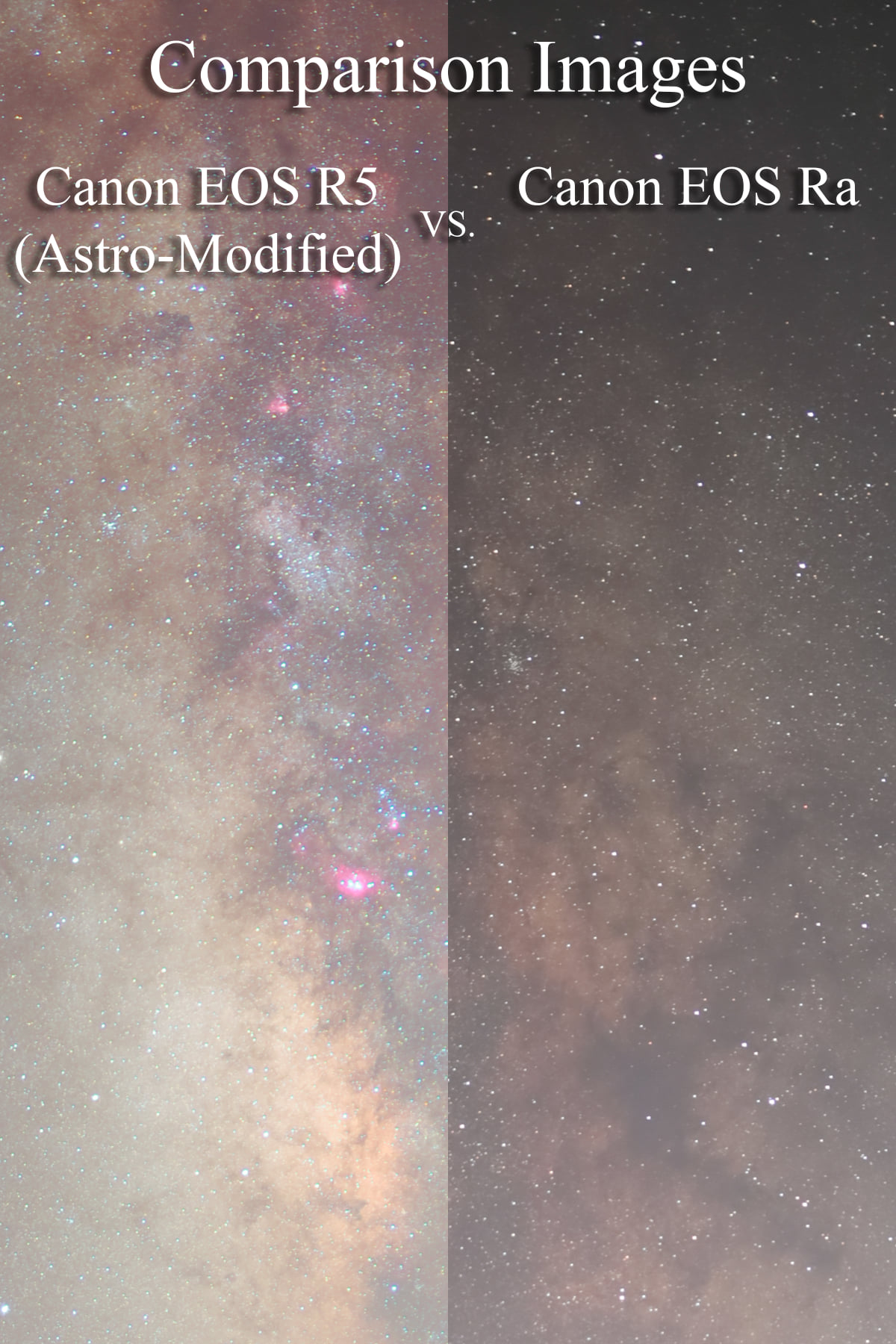
Comparison images captured using an Astro-modified Canon EOS R5 with the Visible + H-Alpha internal filter option and a Canon EOS Ra. Identical lens and identical settings. As is obvious, the modified camera out performs the astrophotography specific Canon EOS Ra with much more sensitivity to light (Increased Luminance) especially more sensitivity to the H-Alpha portion of the EM spectrum.
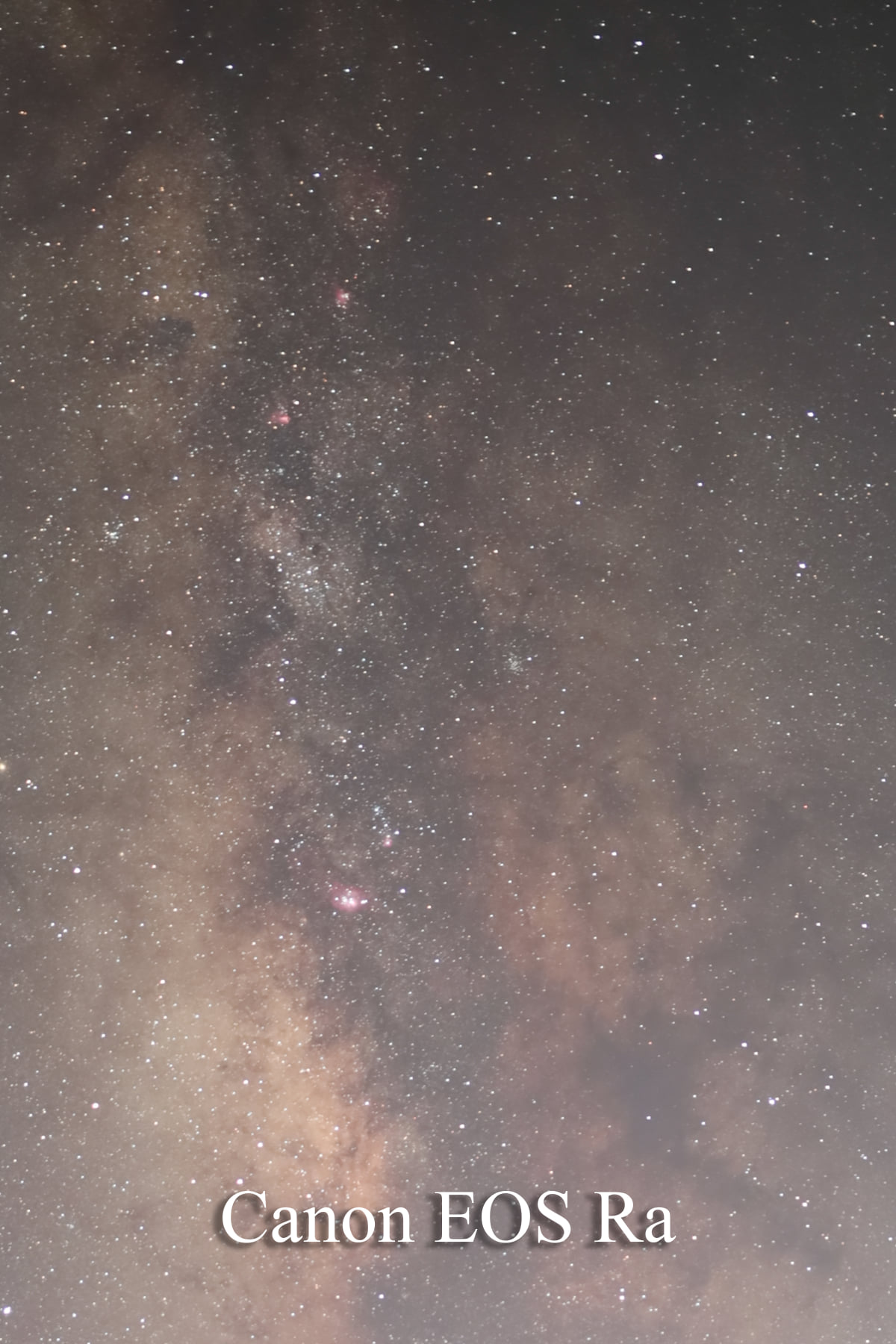
Comparison images captured using an Astro-modified Canon EOS R5 with the Visible + H-Alpha internal filter option and a Canon EOS Ra. Identical lens and identical settings. As is obvious, the modified camera out performs the astrophotography specific Canon EOS Ra with much more sensitivity to light (Increased Luminance) especially more sensitivity to the H-Alpha portion of the EM spectrum.
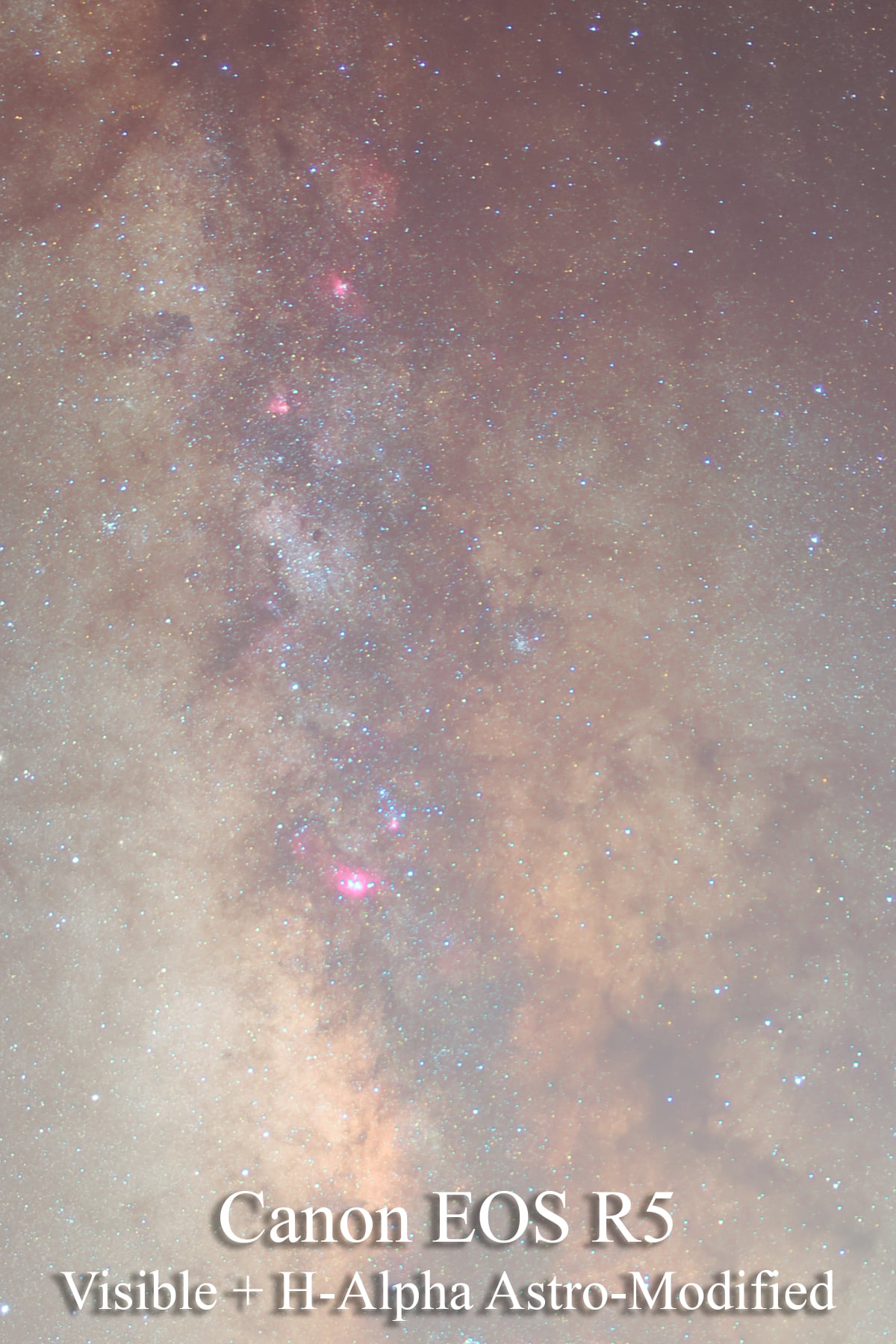
Comparison images captured using an Astro-modified Canon EOS R5 with the Visible + H-Alpha internal filter option and a Canon EOS Ra. Identical lens and identical settings. As is obvious, the modified camera out performs the astrophotography specific Canon EOS Ra with much more sensitivity to light (Increased Luminance) especially more sensitivity to the H-Alpha portion of the EM spectrum.
2 Spectrum Filter Option: Our 2 Spectrum Filter will block UV light from reaching the imaging sensor of the camera which can help produce a cleaner final image. It will still allow the camera to capture all of the Visible and into the near Infrared portions of the spectrum (including H-Alpha, Oxygen III, Sulfer II, and H-Beta). This filter is only recommended if you do not wish to capture any UV images anytime in the future. The Full Spectrum option is our first recommendation for most Astrophotographers but this filter can help provide a better result especially when using the camera for daytime subjects.
***New - We can now reinstall the Dust Reduction System (Automatic Sensor Cleaner) in virtually every camera model.
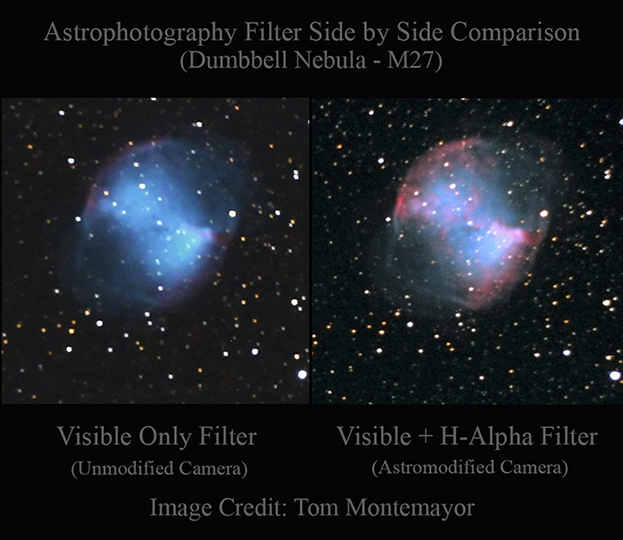
Astrophotography, IR and Normal Photography, all with one Camera Body.
Shooting Astrophotography, IR and normal/visible photography can be performed with one camera. The best filter choice to achieve this is the Full Spectrum/Clear filter option. Once the conversion has been performed all you need is a UV/IR cutoff filter on your lens to capture normal/visible light images including landscapes and portraits. In order to shoot IR with the same camera all you need is an IR filter of your choice for your lens. With each filter all you need to do is set a custom white balance and your on you're way. Also, simply remove the filter from your lens for full spectrum/clear astrophotography which includes the UV, IR and visible portions of the EM spectrum. (Order an Astro-Conversion here)
(Attention Canon Shooters! Some canon full frame models can show a light leak when capturing High ISO Long Exposure images. This is easily remedied by switching off Liveview before capturing the image.)
Testimonials:
Clarence:
Wow, working with you is just like working with my crew space support group at NASA. I love working with can-do people. Thanks for the follow up info here. It all looks good to me and I know we will put together the best camera produced. It is a pleasure to work with such dedicated people. Let me know if you have any issues/questions in dealing with NASA.
Again, it is a pleasure to be working with you.
Don Pettit (PH.D.)– NASA Astronaut
ISS Expedition 6 Crew Member; Space Shuttle STS-126 Crew Member; Current ISS Expedition 30 and 31 Crew member.
http://www.jsc.nasa.gov/Bios/htmlbios/pettit.html
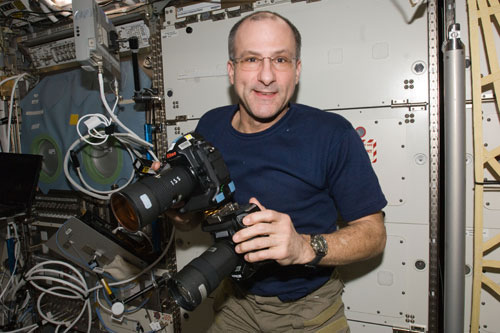
NASA/International Space Station Astronaut Don Pettit works with two still cameras mounted together, one of which is an infrared modified still camera, modified by Spencer's Camera & Photo of Alpine, Utah. Photo credit: NASA
Dear Clarence,
I got a standard Sony NEX-5 camera and found it’s a single shot colour images quite good. However I was not satisfied with the red colour spectrum in the deep space images and decided to get a conversion done.
It was a pleasure to deal with Spencer’s Camera and my new kit arrived quickly. What a difference it made! The colours are rich and there is less visible noise.
Thanks for the high quality service!
Alex Cherney
Amateur astronomer and photographer
http://www.terrastro.com
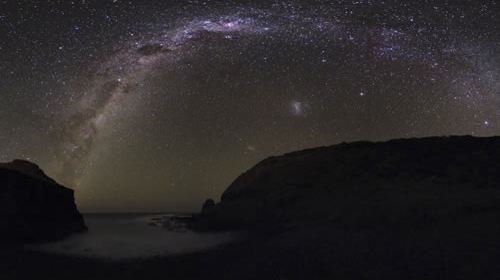
Image Copyrighted - Alex Cherney 2011



